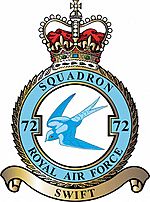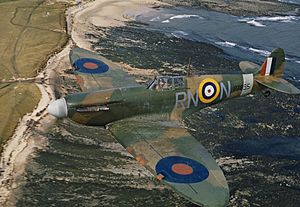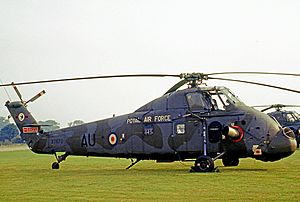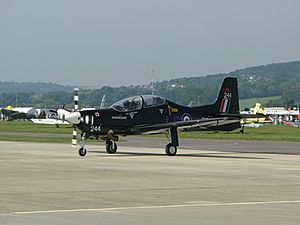No. 72 Squadron RAF facts for kids
Quick facts for kids No. 72 (Fighter) Squadron RAF |
|
|---|---|

Squadron badge
|
|
| Active | 28 June 1917 – 1 April 1918 (RFC) 1 April 1918 – 22 September 1919 (RAF) 22 February 1937 – 30 December 1946 1 February 1947 – 30 June 1961 15 November 1961 – 1 April 2002 12 July 2002 – 31 October 2019 28 November 2019 – present |
| Country | |
| Branch | |
| Type | Flying training squadron |
| Role | Advanced flying training |
| Part of | No. 4 Flying Training School RAF |
| Home station | RAF Valley |
| Nickname(s) | 'Basutoland' |
| Motto(s) | Swift |
| Aircraft | Beechcraft Texan T.1 |
| Battle honours |
|
| Insignia | |
| Squadron badge heraldry | A swift volant, intended to symbolise speed. |
| Post 1950 squadron insignia | |
| Squadron codes | RN (Oct 1938 – Apr 1939) SD (Apr 1939 – Sep 1939) RN (Sep 1939 – Dec 1946) FG (Jan 1947 – Apr 1951) AA–AZ (Wessex) |
Number 72 (Fighter) Squadron is a special unit of the Royal Air Force (RAF). Today, it's a training squadron based at RAF Valley. Its job is to teach pilots how to fly fast jets using the Beechcraft Texan T.1 aircraft.
This squadron has a long and interesting history. It started by helping the army during World War I in the Middle East. After that, it became a fighter unit, flying famous planes like the Supermarine Spitfire during the Battle of Britain. Later, it flew powerful Gloster Javelin jets. From 1961 until 2002, the squadron changed roles and flew helicopters to transport people and supplies.
The squadron's nickname, "Basutoland," comes from a special reason. During both World Wars, a country called Basutoland (now Lesotho) gave aircraft to the RAF. These planes were then given to No. 72 Squadron.
Contents
Squadron History
Early Days: First World War
No. 72 Squadron first started on June 28, 1917, at Upavon. It was part of the Royal Flying Corps, which was the air force before the RAF. On Christmas Day that year, the squadron moved to the Middle East. They set up their base in Basra on March 2.
Once there, the squadron split into three smaller groups. Each group helped the army with different missions. After their work was done, the squadron was officially closed down in Baghdad on September 22, 1919.
World War II: A Fighter Squadron

No. 72 Squadron was formed again on February 22, 1937, at RAF Tangmere. In 1939, the squadron received Supermarine Spitfires. These amazing planes replaced their older Gloster Gladiator biplanes.
When World War II began, the Spitfires were used to defend the air and protect ships carrying important goods. In 1940, the squadron helped with the evacuation of Dunkirk, a very important rescue mission.
During the famous Battle of Britain, No. 72 Squadron was first based at RAF Acklington. In September, they moved south to join the main defence force. Later, the squadron moved to North Africa to help in the Tunisian campaign. In 1942, they got updated Spitfire Mk.IX planes. They then helped the British 8th Army as they moved through Italy and France. The squadron was closed down again on December 30, 1946, in Austria.
Post-War Jets and Helicopters
The squadron was reformed once more on February 1, 1947, at RAF Odiham. They started flying Vampire F.1 jets. These were replaced by Gloster Meteor F.8 jets in 1952. In 1956, the squadron took on a new role: night-fighter. For this, they used Meteor NF.12s and NF.14s.
In April 1959, the squadron became an all-weather fighter unit. They flew Gloster Javelin FAW.4s and later FAW.5s. These powerful jets were used until the squadron was closed down on June 30, 1961.

On November 15, 1961, No. 72 Squadron was formed again at RAF Odiham. This time, it became a helicopter unit! They first used Bristol Belvederes HC.1s. In August 1964, these were replaced by the Westland Wessex HC.2.
For the next 38 years, they continued to use the Wessex helicopters. During this time, the squadron helped in Malaya. They also provided aid after the Torrey Canyon oil tanker disaster in 1967. From 1969, they supported security forces in Northern Ireland. In 1997, they also started using the more modern Westland Puma HC.1. The Wessex helicopters left in March 2002, and the squadron was closed down on April 1, 2002.
Modern Training: Tucano to Texan
No. 72 Squadron was brought back on July 12, 2002. It became a reserve squadron for No. 1 Flying Training School. Both No. 72 (Reserve) Squadron and No. 207 (Reserve) Squadron flew the Short Tucano T.1 at RAF Linton-on-Ouse.
On February 1, 2018, the "Reserve" part was removed from the squadron's name. The last group of pilots trained on the Tucano graduated on October 25, 2019. This was celebrated with nine planes flying together. No. 72 Squadron was then closed down on October 31, 2019.
However, the squadron was quickly reformed on November 28, 2019, at RAF Valley. Now, they fly the Beechcraft Texan T.1. On November 13, 2020, No. 72 Squadron officially became No. 72 (Fighter) Squadron again. This change was made to remember its important past as a fighter unit.
Aircraft Used by the Squadron
No. 72 Squadron has flown many different aircraft throughout its history. Here are some of the main types:
- World War I: Airco DH.4, Spad S.7, Martinsyde G.100, S.E.5A, M.1c
- World War II: Gloster Gladiator, Supermarine Spitfire (various models)
- Post-War Jets: de Havilland Vampire (F.1, F.3, FB.5), Gloster Meteor (F.8, NF.12, NF.14), Gloster Javelin (FAW.4, FAW.5)
- Helicopters: Bristol Belvedere (HC.1), Westland Wessex (HC.2), Westland Puma (HC.1)
- Training Aircraft: Short Tucano (T.1), Beechcraft Texan (T.1)
See also
- List of Royal Air Force aircraft squadrons




